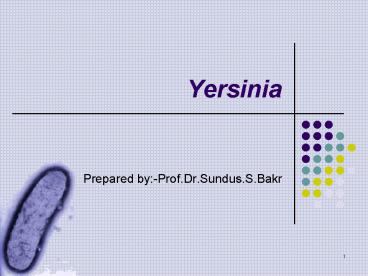Yersinia - PowerPoint PPT Presentation
1 / 29
Title:
Yersinia
Description:
Yersinia Prepared by:-Prof.Dr.Sundus.S.Bakr * * * * Picture of bacteria Yersinia and on the agar, rod shape * Picture from the microscope Gram negative shows the red ... – PowerPoint PPT presentation
Number of Views:1078
Avg rating:3.0/5.0
Title: Yersinia
1
Yersinia
- Prepared by-Prof.Dr.Sundus.S.Bakr
2
Yersinia
- Member of Enterobacteriaceae
- Gram negative, small rod shape
- Y. enterocolitica,
- Y. pseudotuberculosis,
- Y. pestis
3
- Cells of Yersinia are small 1mm or less on
nutrient agar - Y. enterocolitica, Y. pseudotuberculosis, Y.
pestis are the three pathogenic species - Y. enterocolitica and Y. pseudotuberculosis cause
the food borne disease. - Y. Pestis causes the bubonic plague or black
death in Europe
4
Yersinia
5
Yersinia
Gram-negative rods.
Small rods
6
Yersinia
Yersinia
Enterobacteriaceae
Growth of Y. enterocolitica on blood agar medium
7
Yersinia
18 hours incubation on MacConkey Agar at 37C
18 hours incubation on Yersinia entreo Selective
Agar at 37C
8
Yersinia
- Low temperature pathogen
- Able to grow at 4C
- Some biochemical characteristics are temperature
dependent - expose at 28-30C but not at 37C
- Mobile below 30C but not at 37C
- Incubation at 37C ?loss of the virulence plasmid
plasmid mediated properties - Yersinia is psychrotroph.
- So, may continue to grow under refrigeration
9
Yersinia
Influence of incubation temperature in the
motility of Y. enterocolitica
10
- At 28C Y. enterocolitica is motile and is seen
(arrowed) spreading away from the stab inoculums
during growth in semi-solid medium. - At 37C, the org. is non-motile
11
Yersiniosis
- Infectious disease caused by Yersinia
- Only Y. enterocolitica and Y. pseudotuberculosis
cause gastroenteritis - Symptoms
- Gastroenteritis
- Abdominal pain, diarrhea (often bloody) ,
vomiting, fever - In older children and adults, right-sided
abdominal pain (pseudo-appendicitis) - Right sided abdominal pain may be confused with
appendicitis. - In a small proportion of cases, complications
such as skin rash, joint pains, or spread of
bacteria to the bloodstream can occur.
12
Yersiniosis
- Onset illness, between 24 to 48 hours after
ingestion - Occasional Y. enterocolitica GI infection
followed by arthritis of peripheral joints - 2 - 6 weeks after intestinal infection clears
- Called reactive arthritis (Reithers syndrome)
- may occur even in the absence of obvious
symptoms.
13
Yersiniosis
VS
Bacterial antigen
Arthritis of peripheral joint (post food
poisoning consequences)
- The frequency of postenteritis arthritic
conditions is about 2-3
14
- Can occur with people who has human lymphocyte
antigen B27 (HLA-B27) the antigen exposed on the
host cell - Thought to be caused by T-cells and/or antibodies
- elicited by antigens that cross-react with host
antigens, not by infection of the joints - common in people with histocompatibility antigen
HLA-B27 (exposed on surface of host cells) - antibodies vs. bacterial surface antigens
cross-react with human B27, activate C' - T-cells recognizing B27 may attack host cells
15
Yersinia enterocolitica
- Optimum temperature 22-29C (range of -2 to 45C)
- Foods involved in transmission
- Meats (pork, beef, lamb, etc.)
- Oysters, fish
- Raw milk
- Prevalent in the soil and water and in animals
such as pigs
16
Yersinia enterocolitica
- Infected by
- Eating contaminated food ? raw or undercooked
pork products - Drinking contaminated unpasteurized milk or
untreated water - Susceptibility
- Infants, children
- Compromised adults
- individuals with the antigen HLA-B27
(postenteritis arthritis)
17
Yersinia pestis
18
Hosts of Yersinia pestis
- Mammalian
- Human
- Rodent
- Insect
- Xenopsylla cheopis
http//www.channel4.com/history/ microsites/H/hist
ory/plaegu/plague.html Science Picture Library
www.exn.ca/Stories/ 2000/09/12/52.asp
19
Symptoms
idcs0100.lib.iup.edu/ WestCivI/the8.htm
www.imcworldwide.org/ cbr/L1C-m2.html
http//aci.mta.ca/Courses/Biology/Images/bacterial
20folder/Plague.html
- Bubonic
- Pneumonic
- Septicemic
www.niaid.nih.gov/dir/ labs/lhbp/hinnebusch.htm
20
Transmission Cycles The transmission cycle of Y.
pestis is vector-dependent, and is usually
dependent on X. cheopis, the rat flea
www.pon.nic.in/fil-free/ vcrc/plague.html
21
Diagnosis
- Diagnosis is based primarily on clinical
suspicion - USAMRIID - Staining
- Culture
http//www.cdc.gov/ncidod/dvbid/plague/p4.htm
www.einsamer-schuetze.com/natur/krankheit/pest/bed
rohung.html
22
- Diagnosis for Y. pestis is based on staining
blood, sputum, CSF or lymph node aspirates with
Gram, Wayson or Giemsa staining, but a definitive
diagnosis requires a culture. - The green picture at the top of the slide is a
presumptive positive confirmation via
immunofluoresence for the presence of F1
antigen, which is specific to the Y. pestis .The
tan picture Is an SEM image of Y. pestis from
culture. - Currently, only culturing is the definitive
method of confirming a diagnosis of bubonic
plague, - The Rapid Detection Test is being
collaboratively developed by the WHO Coll.
Center for Plague in Madagascar and France, as
well as the Ministry of Health in Madagascar
23
Treatment
- ANTIBIOTICS- streptomycin ,ciprofloxacin or
doxycycline - Development of resistant strains
http//content.nejm.org/cgi/content/full/337/10/67
7
24
Pathogenesis
- Evolution
- Plasmids
- Type III Secretion
- Virulence Factors
dr-gng.dp.ua/death/ black/death_0.htm
25
Plasmids
- pPCP1 interferes with blood coagulation.
- pPMT1 have a role in resisting monocytic
phagocytosis. - pCD1 the most important plasmid necessary for
virulence in Y. pestis.
http//tecfaetu.unige.ch/wiki/index.php/PrincipeTr
ansgenese
26
Type III Secretion
- Yersinia pestis relies on Type III secretion for
many of its anti-immune system properties - A major component of Type III secretion is the
Injectisome - Yops inhibit phagocytosis
27
Virulence Factors
- Invasins
- Tyrosine Phosphatase
- , Y. pestis is well equipped to both avoid
phagocytosis and to deal with engulfment
http//www.jbc.org/cgi/content/full/280/11/10388
28
Detection
- Rapid Detection Test
- The RDT is a test sensitive to the presence of
the plague-specific F1 antigen using monoclonal
antibodies.
www.allwestselectsires.com/ ecf.asp
www.testsymptomsathome.com/ TEC01.asp
29
Thank you































![Impact of an external energy on Yersinia enterocolitica [ATCC–23715] in relation to antibiotic susceptibility and biochemical reactions: An experimental study PowerPoint PPT Presentation](https://s3.amazonaws.com/images.powershow.com/8845637.th0.jpg?_=20170526075)